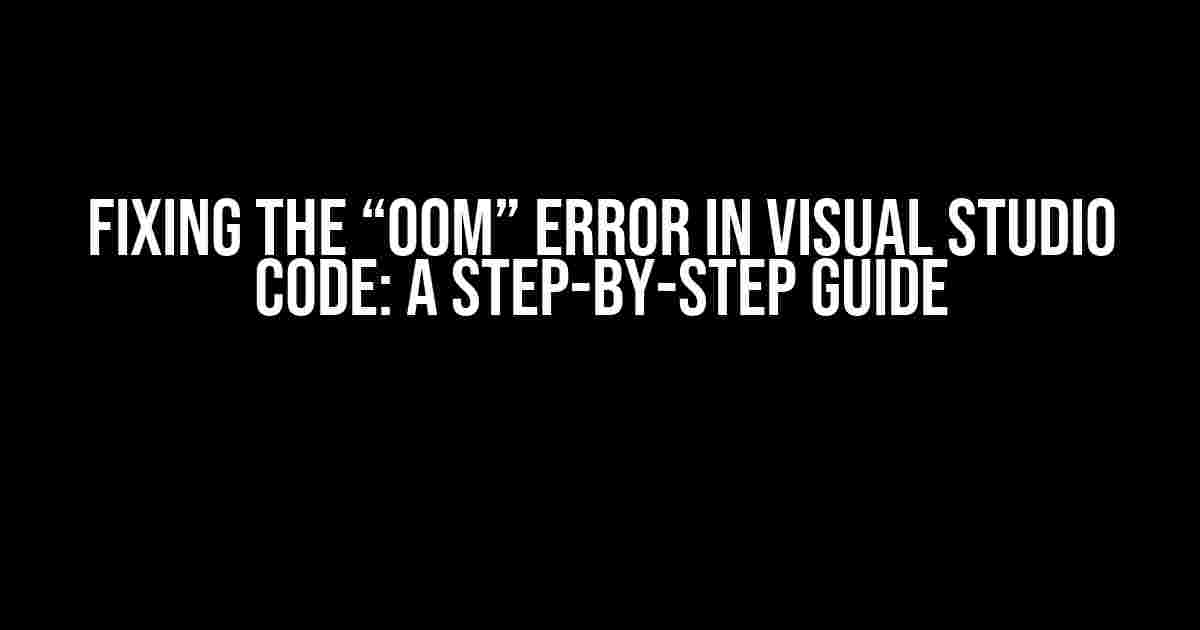Are you tired of encountering the frustrating “OOM” error in Visual Studio Code? You’re not alone! Many developers have struggled with this issue, which can bring your coding workflow to a grinding halt. But fear not, dear reader, for we’ve got a comprehensive guide to help you fix this pesky problem once and for all.
- What is the “OOM” Error?
- Fixing the “OOM” Error: Method 1 – Increase System Memory
- Fixing the “OOM” Error: Method 2 – Disable Resource-Intensive Extensions
- Fixing the “OOM” Error: Method 3 – Clear VS Code Cache and Data
- Fixing the “OOM” Error: Method 4 – Update VS Code and Extensions
- Fixing the “OOM” Error: Method 5 – Disable Hardware Acceleration
- Fixing the “OOM” Error: Method 6 – Check for System Updates
- Troubleshooting the “OOM” Error: Advanced Methods
- Conclusion
What is the “OOM” Error?
The “OOM” error, also known as the “Out of Memory” error, occurs when Visual Studio Code runs out of memory while trying to execute a task. This can happen due to various reasons, such as:
- Insufficient system memory
- Large project files or complex codebases
- Buggy extensions or plugins
- Corrupted VS Code configurations
The error message usually looks something like this:
Erro (reason: 'oom', code: '-536870904')Fixing the “OOM” Error: Method 1 – Increase System Memory
One of the most straightforward ways to resolve the “OOM” error is to increase your system’s memory. This is especially crucial if you’re working with large projects or complex codebases. Here’s how to do it:
- Check your system’s available memory by pressing the Windows key + R, typing “systeminfo” in the Run dialog, and pressing Enter.
- Close any unnecessary applications or background processes to free up memory.
- Consider upgrading your system’s RAM if you’re running low (at least 8 GB is recommended).
Fixing the “OOM” Error: Method 2 – Disable Resource-Intensive Extensions
Sometimes, a buggy or resource-intensive extension can cause the “OOM” error. To troubleshoot this:
- Open Visual Studio Code and navigate to the Extensions panel by clicking the Extensions icon in the left sidebar or pressing Ctrl + Shift + X.
- Disable all extensions one by one, restarting VS Code after each disable.
- Check if the “OOM” error persists after disabling each extension. If it does, move on to the next step.
- If the error disappears after disabling a specific extension, try uninstalling and reinstalling that extension or searching for an alternative.
Fixing the “OOM” Error: Method 3 – Clear VS Code Cache and Data
Corrupted cache and data can also cause the “OOM” error. To clear them:
- Close Visual Studio Code.
- Press the Windows key + R, type “%USERPROFILE%\.vscode”, and press Enter to open the VS Code configuration folder.
- Delete the following folders and files:
- .vscode
- Code Cache
- GPUCache
- Storage
- Restart Visual Studio Code.
Fixing the “OOM” Error: Method 4 – Update VS Code and Extensions
Outdated Visual Studio Code or extensions can also lead to the “OOM” error. To update:
- Open Visual Studio Code and navigate to the Extensions panel.
- Click the “…” icon at the top-right corner of the Extensions panel and select “Check for Extensions Updates.”
- Update all available extensions.
- Check if a new version of Visual Studio Code is available by clicking the gear icon in the bottom-left corner of the VS Code window and selecting “Check for Updates.”
- Update Visual Studio Code if an update is available.
Fixing the “OOM” Error: Method 5 – Disable Hardware Acceleration
Hardware acceleration can sometimes cause memory issues in Visual Studio Code. To disable it:
- Open Visual Studio Code and navigate to the Command Palette by pressing Ctrl + Shift + P.
- Type “GPU: Disable” in the Command Palette and select the corresponding option.
- Restart Visual Studio Code.
Fixing the “OOM” Error: Method 6 – Check for System Updates
System updates can often resolve memory-related issues that cause the “OOM” error. To check for updates:
- Press the Windows key + I to open the Settings app.
- Click “Update & Security.”
- Click “Check for updates.”
- Install any available updates.
Troubleshooting the “OOM” Error: Advanced Methods
If the above methods don’t resolve the “OOM” error, it’s time to dive deeper into advanced troubleshooting techniques:
Method 7: Checking System Event Logs
To check system event logs:
- Press the Windows key + R, type “eventvwr”, and press Enter to open the Event Viewer.
- Navigate to the “Windows Logs” section and filter the logs by “System” and “Error” levels.
- Look for any error messages related to memory or Visual Studio Code.
Method 8: Running VS Code in Safe Mode
To run Visual Studio Code in safe mode:
- Close Visual Studio Code.
- Press the Windows key + R, type “code –safe-mode”, and press Enter to open VS Code in safe mode.
- Check if the “OOM” error persists in safe mode. If it does, the issue is likely with VS Code itself.
Method 9: Checking for System File Corruption
To check for system file corruption:
- Press the Windows key + S, type “sfc /scannow”, and press Enter to run the System File Checker tool.
- Wait for the tool to complete its scan and fix any corrupted system files.
Conclusion
The “OOM” error in Visual Studio Code can be frustrating, but with these comprehensive methods, you should be able to fix it and get back to coding in no time. Remember to try each method step-by-step, and don’t hesitate to reach out to the VS Code community or a professional developer for further assistance.
| Method | Description |
|---|---|
| Method 1 | Increase system memory |
| Method 2 | Disable resource-intensive extensions |
| Method 3 | Clear VS Code cache and data |
| Method 4 | Update VS Code and extensions |
| Method 5 | Disable hardware acceleration |
| Method 6 | Check for system updates |
| Method 7 | Check system event logs |
| Method 8 | Run VS Code in safe mode |
| Method 9 | Check for system file corruption |
By following these methods, you’ll be well on your way to resolving the “OOM” error and enjoying a smoother coding experience in Visual Studio Code.
Here are 5 Questions and Answers about “how to fix Visual Studio Code error (reason: ‘oom’, code: ‘-536870904’)”:
Frequently Asked Question
Stuck with the frustrating “oom” error in Visual Studio Code? Worry not! We’ve got the solutions to get you back to coding in no time.
What does the “oom” error in Visual Studio Code mean?
The “oom” error stands for “out of memory”, which means that Visual Studio Code has run out of memory to perform the requested operation. This error is usually caused by a memory leak or an issue with the system or process that’s consuming too much memory.
How can I increase the memory limit in Visual Studio Code?
You can increase the memory limit in Visual Studio Code by adding the following lines to your `settings.json` file: `”algo.rulers.maxSize”: 1000000` and `”files.watcherExclude”: “**/.git/objects/**”`. You can also try updating your Visual Studio Code to the latest version.
What are some common causes of the “oom” error in Visual Studio Code?
Some common causes of the “oom” error in Visual Studio Code include large files or projects, excessive use of extensions, outdated versions of Visual Studio Code, and system resource issues. It’s essential to identify the root cause to apply the right solution.
Can I disable certain extensions to fix the “oom” error?
Yes, you can try disabling certain extensions that may be consuming excessive memory. Go to the Extensions panel, find the suspicious extension, and toggle the switch to disable it. You can also try disabling all extensions and then re-enabling them one by one to identify the problematic one.
Are there any alternative solutions to fix the “oom” error?
If the above solutions don’t work, you can try closing other memory-intensive applications, restarting Visual Studio Code, or even reinstalling it. Additionally, you can try using the `–max-old-space-size` flag when launching Visual Studio Code to increase the memory limit.


